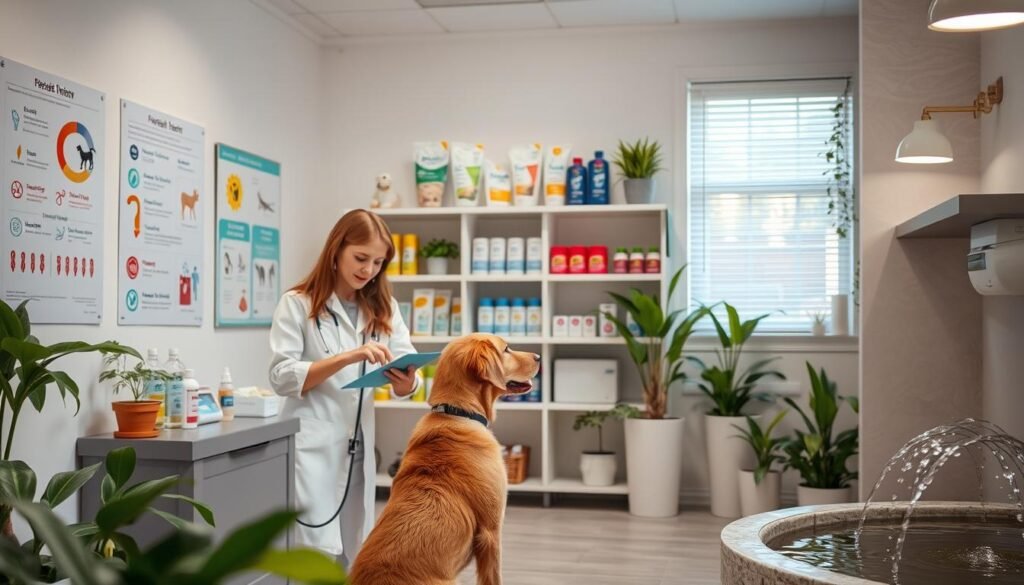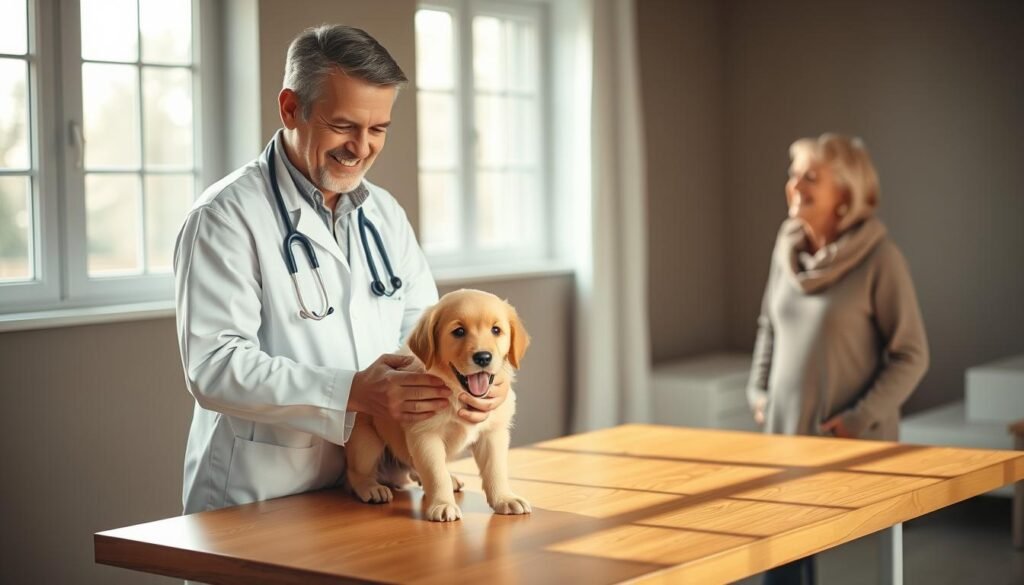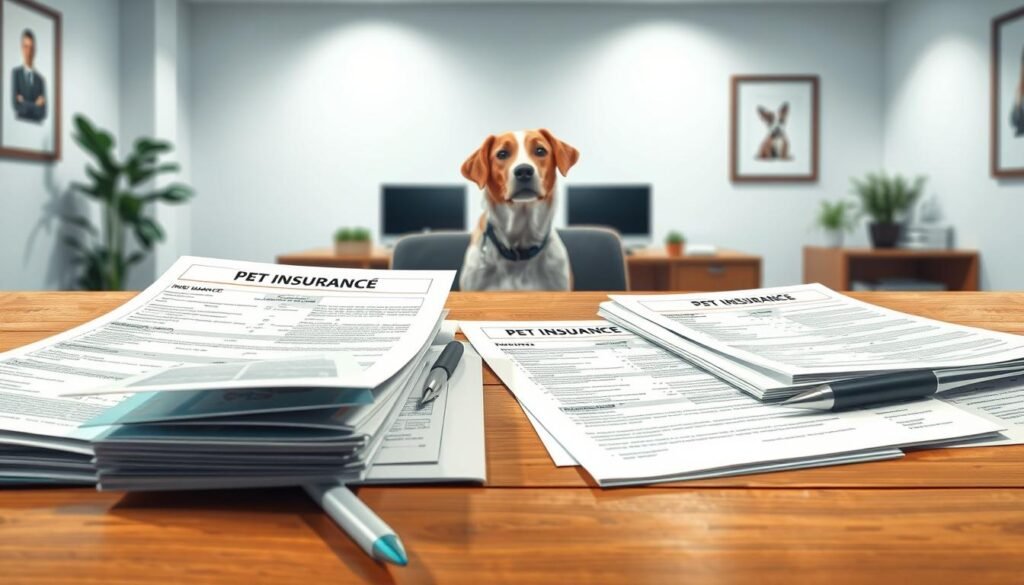Puppies and kittens grow fast, so they need vet visits often. They need wellness exams every 3 to 4 weeks from 6 to 20 weeks old1. This helps catch health problems early.
As they get older, adult pets need yearly checkups. Seniors, like dogs over 7 years old, need visits every 6 months1.
Preventive care is key for health and saving money. Annual fecal exams and heartworm tests prevent expensive treatments later1. But, 60% of pet owners skip these visits, risking health problems2.
Even core vaccines, like rabies, have strict schedules. Puppies and kittens start at 8 and 9 weeks, respectively3.
Vet costs vary a lot—San Francisco’s average is $406, almost double rural areas’ $2651. Early care can add 15% to a pet’s life and cut serious illness risks by 50%2. Let’s explore how these routines improve animal health without costing too much.
Key Takeaways
- Puppies and kittens need wellness exams every 3-4 weeks until 5 months old1.
- Senior pets over 7 years require checkups every 6 months for optimal health1.
- 60% of pet owners skip annual exams, risking undiagnosed issues2.
- Core vaccines for puppies start at 8 weeks, with boosters at 12 months3.
- Regular care lowers serious illness risks by up to 50% and extends lifespan by 15%2.
Importance of Regular Vet Visits
Regular vet visits keep pets healthy for a long time. They help find problems like diabetes or kidney disease early. This makes treatment easier and cheaper4.
Understanding Preventive Care
Routine visits include:
- Blood and urine tests to monitor organ function4.
- Vaccinations against diseases like rabies and distemper5.
- Screenings for parasites and dental disease6.
Pets are experts at hiding pain, meaning by the time symptoms appear, they may already be in significant distress4.
Visit frequency varies by age:
- Puppies/kittens: 3–4 week visits until 16 weeks, then every 6 months5.
- Adult pets (1–7 years): yearly exams to track weight and health trends5.
- Seniors (7+ years): twice yearly visits to manage chronic conditions5.
Early detection cuts costs dramatically. Diabetes treatment costs drop by 70% when caught early through blood tests4. Preventive care also extends lifespans by catching issues like heartworm before they become irreversible46.
Skipping vet visits risks missing silent health crises. Annual exams with trusted veterinary services create a safety net for your pet’s well-being56.
Common Health Issues in Pets
Spotting symptoms early is key to protecting pet health and ensuring animal wellness. Regular observation helps owners catch issues before they worsen. Many conditions, like obesity or dental disease, affect a large portion of pets and require prompt action.

“Dental disease affects 80% of dogs by age 3, making it a critical concern for pet owners.”7
Identifying Symptoms Early
Common issues like allergies, skin infections, and obesity demand attention. Over 50% of US dogs are overweight or obese7, raising risks like diabetes and arthritis8. Symptoms like reduced activity, vomiting, or changes in bathroom habits signal deeper problems.
- Dental disease starts early: 80% of dogs show signs by age three7.
- Brachycephalic breeds like Bulldogs face respiratory struggles and dental crowding9.
- Allergies impact 10% of dogs, causing itching or ear infections7.
Brachycephalic breeds like Pugs and Bulldogs need extra care. Their flat faces lead to breathing issues and eye injuries9. Regular checks for nasal folds and dental cleanings are vital for these pets.
Watch for behavioral shifts. Lethargy, loss of appetite, or unusual lumps should prompt vet visits. Early action improves outcomes for conditions like urinary infections or arthritis affecting 20% of older dogs7. Prioritizing preventive steps keeps pets healthy and reduces severe treatments later.
Vaccinations Your Pet Needs
Protecting pets starts with understanding core vaccines. These are shots all animals need, no matter their lifestyle. They protect against serious, contagious diseases10. Non-core vaccines, like Lyme or feline leukemia, depend on your pet’s environment and habits. Talking to veterinary services helps tailor protection11.
Core vs. Non-Core Vaccines
Dogs need core vaccines for rabies, distemper, and parvovirus. Cats need shots for panleukopenia and feline herpesvirus1011. Non-core vaccines include Lyme disease for outdoor dogs or feline leukemia for cats that socialize12.
| Type | Dogs | Cats |
|---|---|---|
| Core | Rabies, DA2PP12 | Rabies, FVRCP11 |
| Non-Core | Lyme, Leptospirosis10 | FeLV, Bordetella12 |
Vaccination timing is key. Puppies start shots at 6-8 weeks, with boosters every 3-4 weeks until 16 weeks10. Adult pets get shots based on vet advice. Costs vary, with core vaccines like rabies costing $20-$30 per dose12.
“Core vaccines save lives by creating immunity before exposure to disease.” —AVMA Veterinary Guidelines
Watch pets after shots for swelling or lethargy10. Serious reactions are rare but need veterinary services right away. Keep vaccine records to ensure your pet stays protected11.
Nutrition and Diet for Your Pet
Choosing the right food is key to your dog’s health. A balanced diet gives them energy, keeps their immune system strong, and supports their long-term health. Look for commercial foods that meet AAFCO standards. These ensure your pet gets all the necessary nutrients.
- Proteins: Growing dogs need 18% DM protein, while adults require 8% DM13.
- Fats: Aim for 1–2% fat for vitamin absorption and energy13.
- Carbohydrates: Puppies need at least 20% carbs for energy, while senior diets often reduce carbs to 30–60%1314.
- Vitamins: AAFCO recommends specific levels like 5,000 IU/kg DM vitamin A and 50 IU/kg DM vitamin E13.

When reading labels, look for high-quality protein sources. Avoid foods with too many fillers. For adult dogs, feed 30 x (weight in kg) + 70 calories daily14. Senior dogs over 7 years need lower calories and joint-support ingredients like glucosamine14.
Puppies need 4–6 meals daily until 8 weeks, then 2–3 meals until 6 months. Large-breed puppies need special formulas to avoid growth issues14. Always talk to your vet before changing your pet’s diet, especially if they have allergies or obesity. Remember, water is the most important nutrient for your pet14.
Exercise and Its Role in Pet Health
Active play and daily movement are crucial for pet health. Each breed has its own needs. For instance, high-energy dogs need lots of runs, while indoor cats prefer less.
Border collies, for example, need 2+ hours of exercise every day. Older pets might enjoy gentle walks. Always choose activities that fit your pet’s age and size.
- High-energy breeds (Labradors, huskies): 90+ minutes daily)
- Low-energy breeds ( Bulldogs, Persian cats: 30–60 minutes)
- Seniors or smaller pets: Short, frequent sessions
“Exercise prevents obesity, strengthens muscles, and improves mood.”
Walking, fetch, or interactive toys help burn energy and reduce boredom. For cats, climbing towers or feather toys are great. Even birds benefit from flying or perching exercises15.
Always talk to your vet before starting new exercises, especially for pets with joint issues16.
Outdoor adventures like hiking or swimming boost health and mental stimulation17. Tailoring exercise to your pet’s needs supports their wellness. It also strengthens your bond and keeps them happy. Make sure it’s fun and safe!
Grooming Your Pet: An Essential Habit
Regular dog grooming is more than just making your pet look good. It’s a key part of pet care that keeps them healthy and happy. By brushing, bathing, and checking your pet every week, you can spot problems early. This helps prevent small issues from becoming big ones18.

Begin with brushing. Short-haired dogs like Beagles or Bulldogs need a weekly brush. Long-haired dogs, such as Shih Tzus, need daily brushing to avoid mats19. Use a soft brush and go slow to help your pet feel comfortable. For nails, trim them every 2–3 weeks to avoid pain when walking20. Always have styptic powder ready for any cuts.
- Baths: Most dogs need a bath every 1–3 months, depending on how active they are. Use dog-specific shampoos to keep their skin from getting dry20.
- Ear cleaning: Clean ears weekly with a vet-approved solution to stop infections. This is especially important for breeds with floppy ears like Cocker Spaniels18.
- Eye care: Check eyes daily for redness or discharge during grooming sessions18.
Professional dog grooming is great for breeds with hard-to-manage coats, like Poodles or Collies. But simple home routines can also help a lot. Brushing your pet’s teeth 2–3 times a week can reduce tartar and improve their breath18. If your pet doesn’t like grooming, start with short sessions and use treats to make it positive.
Remember, regular dog grooming is not just about keeping them clean. It’s a way to bond with your pet and protect their health for the long term. Ask your vet for advice that fits your pet’s breed and lifestyle.
Dental Care for Your Pet
Dental care is key for pet health, but many owners forget about it until it’s too late. By age three, over 80% of dogs and cats show signs of oral disease2122. Daily brushing removes plaque before it turns into tartar, saving you from expensive treatments later.
“Dental disease doesn’t just affect the mouth—it can harm the heart, kidneys, and liver.”
Steps to Protect Your Pet’s Mouth
- Brush teeth 2-3 times weekly using pet-safe toothpaste23
- Use dental chews like Purina® Pro Plan® or OraVet® to reduce plaque buildup23
- Apply VetriScience® Perio Support to meals for daily tartar prevention23
Professional cleanings under anesthesia let vets tackle hidden problems beneath the gumline. Costs vary:
| Procedure | Cost Range |
|---|---|
| Oral exam | $50–$100 |
| Ultrasonic cleaning | $200–$300 |
| Advanced surgery | $400–$1,000 |
Regular
starting at age one for small breeds can cut long-term costs by catching issues early22.
Ignoring dental care can lead to pain, tooth loss, and health risks. Schedule annual checkups and ask vets about tailored plans for your pet’s breed and age.
Understanding Parasite Prevention
Parasites can harm pets in ways we might not see. Good pet care means knowing about threats like fleas, ticks, and heartworms. These pests make pets uncomfortable and can spread diseases, hurting animal wellness if not stopped.

Common Parasites and Their Risks
Fleas make pets itch and can cause skin infections. Some pets get allergic dermatitis from them2425. Ticks can give pets Lyme disease, which hurts joints and kidneys24. Heartworms, spread by mosquitoes, harm the heart and lungs and can be deadly without treatment2425.
- Roundworms and tapeworms make pets vomit, have diarrhea, and lose weight25.
- Even pets inside can get sick—mosquitoes can get in, and fleas can ride on clothes24.
“Year-round prevention is key. Monthly medications and environmental cleaning reduce infestation chances,” advises The Colony Animal Clinic in Texas25.
Vets create special plans for pets. They use collars, spot-on treatments, or pills. Washing bedding at 60°C (140°F) weekly kills fleas and their eggs24. Puppies and seniors need extra care because their immune systems are weaker24. Regular vet visits help find parasites before they cause big problems25.
Prevention is better than treatment. Talk to your vet about a plan for your pet. Keeping pets safe from parasites keeps them healthy and your family safe too.
Maintaining a Healthy Weight for Your Pet
More than half of U.S. pets are overweight or obese26. This includes 56% of dogs and 60% of cats27. Being too heavy can lead to diabetes, joint pain, and a shorter life26
A healthy pet should have a body condition score of 3 on a 5-point scale. This means you can feel their ribs under a thin layer of fat26.
Risks of Obesity in Pets
Being overweight triples the risk of arthritis and heart disease. Dogs with a POMC gene mutation, found in 23% of Labradors, have a stronger hunger drive26. Overweight pets also have weaker immune systems and a lower quality of life. Regular weigh-ins every month help track progress26.
Managing weight starts with portion control. Use measuring cups and avoid overfeeding. Choose foods labeled for weight management, which have higher fiber and protein to fill pets up27. Treats should never exceed 10% of daily calories27. Exercise is also key: dogs with 60+ minutes of daily activity are 50% less likely to be obese26.
Tip: Ask your vet for a tailored diet plan. Avoid free-feeding and stick to scheduled meals. Small, gradual changes in exercise prevent injury in heavy pets. Prioritizing pet nutrition and regular vet checks protect long-term pet health. Stay proactive to ensure your pet lives longer and happier!
Regularly Scheduled Wellness Exams
Wellness exams are key for animal wellness. They help vets find health problems early. This makes pets healthier and saves money. 
What Happens During a Wellness Exam?
Every wellness exam has important steps to check your pet’s health:
- Physical exam: Checking eyes, ears, heart, lungs, and joints.
- Labs: Bloodwork, urinalysis, and parasite checks28.
- Vaccinations and parasite prevention updates29.
- Discussion of diet, exercise, and behavior changes.
| Age Group | Recommended Exam Frequency |
|---|---|
| Puppies/Kittens | Monthly until 6 months28 |
| Adult pets (1-7 years) | Yearly exams29 |
| Seniors (7+ years) | Every 6 months28 |
Veterinarians recommend annual exams for 90% of pets30, ensuring ongoing health tracking.
Vets compare current results to past ones during exams. For older pets, they might do X-rays or thyroid tests. This early detection can cut down emergency costs by up to 30%30.
Want to get the most out of your visit? Bring a list of your pet’s habits, appetite changes, or behavior shifts. This helps vets tailor care to your pet’s needs. Regular visits keep pets healthy at every stage of life.
Signs Your Pet Needs Immediate Care
Knowing when your pet needs urgent pet health support can save their life. Spotting red flags early helps pets get to veterinary services before problems get worse.
- Severe symptoms: Watch for seizures over 3 minutes31, trouble breathing, uncontrolled bleeding, or collapse.
- Abnormal behavior: Lethargy, not eating for 24+ hours, or sudden aggression could mean serious trouble.
- Visible trauma: Fractures, deep wounds, or poisoning (like eating toxins) need quick action.
- Neurological changes: Sudden blindness, getting lost, or seizures might mean a stroke or poisoning.
| Symptom | Action | Urgency |
|---|---|---|
| Vomiting > 2x/day | Call vet immediately | 2 hours |
| Blue/pale gums | Transport to emergency clinic | Within 30 mins |
| Unresponsive to stimuli | Activate emergency plan | Immediate |
40% of owners don’t know poisoning signs31, while 25% lack first aid training32. Stay informed to act fast.
Make an emergency plan: Save the number for 24/7 clinics like Northeast Veterinary Referral Hospital31. Have a first aid kit with bandages and a muzzle. Remember, pet health emergencies often happen at night32—know where to find after-hours veterinary services.
- Keep emergency funds set aside (emergency care costs average $800–$2,00032)
- Practice calm handling to avoid injury during transport
Trust your instincts—if something feels wrong, seek help. Quick decisions using this guide can make a big difference in your pet’s recovery.
Finding the Right Veterinarian
Choosing the right vet is key to your pet’s health. A good vet is a partner in your pet’s care, from routine visits to emergencies. Start looking early, before you bring home a new pet, to avoid stress33.

Tips for Choosing a Vet
- Look for AAHA-accredited clinics. They meet over 900 care standards, ensuring top-quality care33.
- Ask friends and family for vet recommendations. Personal referrals are the most trusted way to find a vet33.
- Make sure the clinic offers in-house services like digital X-rays and ultrasounds. This makes pet care faster and more convenient34.
- Check if the clinic is USDA accredited for international travel. This ensures they can provide the health certificates needed33.
- Confirm they give written cost estimates before procedures. Reputable vets are transparent about costs34.
- Look for clinics with payment plans or sliding scales to help manage costs34.
- Choose clinics that focus on “fear free” practices for anxious pets. This makes the experience better for your pet33.
- Ensure the clinic is conveniently located and has good office hours. This makes it easier to schedule visits34.
A good vet values clear communication and respects your pet’s needs. Have a meet-and-greet to see if their approach matches your values. Your pet’s health depends on this partnership.
Emergency Care for Pets
Knowing when and where to seek veterinary services during a crisis can save your pet’s life. Emergencies like poisoning, injuries, or sudden illnesses demand quick action. Here’s how to stay prepared:
- Emergency Facilities Types
– Dedicated 24/7 hospitals (e.g., UrgentVet with 105 locations35)
– Specialty critical care centers
– After-hours clinics offering limited emergency support36 - What Happens During a Visit
– Triage to prioritize cases
– Stabilization (e.g., oxygen, fluids)
– Real-time updates from the vet team
| Emergency Situation | Non-Emergency Issue |
|---|---|
| Poisoning or choking37 | Minor cuts35 |
| Severe bleeding | Hot spots or allergies35 |
| Difficulty breathing | Ear infections35 |
Prepare with these steps:
– Create an emergency kit with first aid supplies37
– Save local emergency clinic phone numbers
– Keep pet boarding providers informed of your vet network
Costs average $800–$1,500 per visit37, but 65% of emergencies happen after office hours37. Always ask if your regular vet partners with emergency facilities to ensure smooth care transitions. Stay calm—their expertise can make all the difference.
The Role of Pet Insurance
Pet insurance helps manage costs tied to pet care by covering unexpected vet bills. For example, pet owners with insurance spend 29% more on dog care38 each year. This shows they feel more secure to get the care their pets need. The cost of pet insurance varies, from $130 to $58439 annually. This is often less than what owners spend on regular and surgical care39.

- Policies vary by coverage: Basic plans may only cover accidents, while comprehensive plans include illnesses and hereditary conditions40.
- Premiums depend on factors like breed (e.g., Bulldogs cost more than small-breed dogs40) and location (urban areas often charge 50% more than rural regions39).
- Reimbursement rates up to 90%40 can offset costs for emergencies like surgeries or chronic diseases.
Plans usually require you to pay upfront for pet care and then submit claims. Most insurers resolve claims in under two weeks40. To make a good choice, compare premiums, deductibles, and exclusions. Starting coverage when pets are young can save money and avoid exclusions for pre-existing conditions40. This ensures your pet’s health is protected without breaking the bank.
Long-term Health Monitoring
Keeping an eye on your pet’s health is crucial for early detection and lifelong wellness. Tools like activity monitors and digital apps make it easy to track weight, sleep, and exercise41. Devices like PetPace collars track vital signs, giving vets real-time data for quicker diagnoses42.
These systems help spot trends that might signal arthritis, diabetes, or other chronic conditions early on.
Regular health records are also key for preventive care. Since 2002, U.S. dogs have lived 11.4% longer thanks to proactive monitoring43. Yet, only 40% of U.S. pets visit the vet annually, missing early intervention chances43.
Combining at-home tracking with regular vet visits creates a strong safety net. Gold Canyon, Arizona’s vets say regular checkups and home data help tailor care for aging pets or those with ongoing health issues.
Apps and collars like PetPace’s telehealth features let owners share trends with vets remotely, reducing clinic visits while ensuring care continues42. For cats, monitoring sleep and activity helps detect arthritis or kidney disease early. This is critical since 23% of U.S. cats miss booster vaccines, risking preventable illnesses43.
Tracking also helps manage weight: devices log calorie intake and exercise, preventing obesity that affects 56% of U.S. pets43.
Building a health timeline with your vet strengthens your pet’s care. Start by logging basics like diet and exercise, then add advanced tools as needed. A well-kept health journal, paired with yearly vet exams, ensures no detail is overlooked. Every small change noted today could prevent bigger issues tomorrow.
FAQ
How often should I take my pet to the veterinarian for checkups?
What are the core vaccines every pet should have?
How can I best protect my pet from parasites?
What signs should I look for to determine if my pet is healthy?
Why is dental care important for my pet?
What should I include in my pet’s nutrition plan?
How do I know if my pet is overweight?
What’s the difference between emergency vets and regular vets?
What is pet insurance and is it worth it?
How can I monitor my pet’s health over the years?
Source Links
- Pet Wellness Exams: How to Prepare – https://www.petmd.com/general-health/pet-wellness-exams-how-prepare
- L&L Animal Urgent Care – https://www.landlanimalurgentcare.com/blog/the-difference-between-routine-vet-visits-and-urgent-care-understanding-your-pets-healthcare-needs
- Pet Wellness Visits: How to Prepare – https://redstarvet.com/news/preparing-for-pet-wellness-visit
- 5 Reasons Your Pet Should Have Regular Veterinary Check-Ups – https://www.zoetispetcare.com/blog/article/regular-veterinary-check-ups
- Why Regular Vet Visits Are Essential for Your Pet’s Health – https://www.cochiseanimalhospital.com/blog/why-regular-vet-visits-are-essential-for-your-pets-health.html
- Early Detection, Lifelong Protection: Why Regular Vet Check-Ups Are Essential for Your Pet’s Health – https://abcvetoflewisville.com/blog/early-detection-lifelong-protection-why-regular-vet-check-ups-are-essential-for-your-pet-s-health
- Top 10 Health Issues in Dogs Every Pet Owner Should Know | Breckinridge Park Animal Hospital – https://www.bpah.net/blog/top-10-health-issues-in-dogs-every-pet-owner-should-know
- Common Pet Illnesses: A Guide for Pet Owners – Animal Hospital of West Woodstock – https://www.animalhospitalofwestwoodstock.com/blog/common-pet-illnesses-a-guide-for-pet-owners/
- Pet Medical Conditions – Primary Care Animal Hospital – https://www.primarycarevet.com/pet-medical-conditions/
- Vaccinations for Your Pet – https://www.aspca.org/pet-care/general-pet-care/vaccinations-your-pet
- The Importance of Vaccinations and Which Ones Your Pet Needs – Pinecrest Veterinary Clinic – https://www.pinecrestvet.com/the-importance-of-vaccinations-and-which-ones-your-pet-needs/
- Puppy and Dog Vaccinations: A Schedule for Every Life Stage – https://www.petmd.com/dog/care/dog-vaccinations-for-every-lifestage
- Dog Nutrition: Guide to Dog Food Nutrients – https://www.petmd.com/dog/nutrition/evr_dg_whats_in_a_balanced_dog_food
- Nutrition – General Feeding Guidelines for Dogs | VCA Animal Hospitals – https://vcahospitals.com/know-your-pet/nutrition-general-feeding-guidelines-for-dogs
- The Importance of Exercise for Your Pet’s Physical and Mental Health | Main Street Veterinary Clinic – https://www.mainstreetvets.co/blog/the-importance-of-exercise-for-your-pets-physical-and-mental-health/
- The Role of Exercise in Pet Health: How to Keep Your Pet Active and Fit – https://www.atlanticveterinaryhospital.net/services/pets/blog/role-exercise-pet-health-how-keep-your-pet-active-and-fit
- The Physical and Mental Benefits of Exercise for Pets – https://thevets.com/resources/pet-health-care/physical-and-mental-benefits-of-exercise-for-pets/
- Maintaining Your Dog’s Well-Being: The Role of Regular Grooming – Howliday Inn Pet Resort – https://howlidayinnpetresort.com/maintaining-your-dogs-well-being-the-role-of-regular-grooming/
- Dog Grooming Tips – https://www.aspca.org/pet-care/dog-care/dog-grooming-tips
- Grooming Your Pet – American Humane Society – https://www.americanhumane.org/public-education/grooming-your-pet/
- Dental Care for Pets: Why It Matters and What It Costs – https://www.carecredit.com/well-u/pet-care/pet-dental-health/
- Preventing dental disease in dogs and cats | CSU Vet Hospital – https://vetmedbiosci.colostate.edu/vth/animal-health/keeping-your-pets-teeth-clean-is-important-to-their-overall-health/
- Dog Dental Care: 6 Ways to Keep a Dog’s Mouth Clean – https://www.petmd.com/dog/general-health/dog-dental-care-6-ways-keep-dogs-mouth-clean
- A Guide to Parasite Prevention for Pets – https://easyvet.com/a-guide-to-parasite-prevention-for-pets/
- Pet Parasite Prevention: What You Need to Know – https://thecolonyanimalclinic.com/blog/pet-parasite-prevention-what-you-need-to-know
- 3 ways to keep your pet at a healthy weight | WALTHAM – http://www.waltham.com/nutrition/three-ways-to-keep-pets-healthy-weight
- Keeping Your Pet at a Healthy Weight – Pet Food Institute – https://www.petfoodinstitute.org/keeping-your-pet-at-a-healthy-weight/
- Wellness Examination in Dogs | VCA Animal Hospitals – https://vcahospitals.com/know-your-pet/wellness-examination-in-dogs
- 7 Crucial Reasons for Pet Wellness Care – Southern Crossing Animal Hospital – https://southerncrossingah.com/7-crucial-reasons-for-pet-wellness-care/
- Dominion Valley Animal Hospital – https://www.dominionvalleyvets.com/blog/why-you-should-schedule-your-pets-wellness-exam-before-the-year-ends
- Northeast Veterinary Referral Hospital – https://www.northeast-vet.com/site/pet-care-blog-plains-vet/2020/08/12/signs-that-your-pet-needs-emergency-veterinary-care
- Brentwood Veterinary Clinic – https://www.brentwoodvet.com/site/blog/2024/02/29/signs-pet-needs-emergency-care
- Finding the Right Vet for Your Cat or Dog – https://www.webmd.com/pets/finding-right-vet-pet
- No title found – https://www.akc.org/expert-advice/health/how-to-find-best-veterinarian/
- UrgentVet Location | Find an Urgent Care Vet Clinic Near You – https://urgentvet.com/locations/
- VEG ER for Pets | 24-hour Emergency Vet – https://www.veterinaryemergencygroup.com/
- Emergency Care for Your Pet – https://www.aspca.org/pet-care/general-pet-care/emergency-care-your-pet
- Is Pet Health Insurance Able to Improve Veterinary Care? Why Pet Health Insurance for Dogs and Cats Has Limits: An Ethical Consideration on Pet Health Insurance – https://pmc.ncbi.nlm.nih.gov/articles/PMC9264770/
- The pros and cons of pet insurance – https://www.empower.com/the-currency/play/pros-cons-pet-insurance
- Is Pet Insurance Worth It & How Does It Work? – https://www.zoetispetcare.com/blog/article/pet-insurance-worth-it
- Pet Monitoring: Keeping Track of Your Pet’s Tracks and More | VCA Animal Hospitals – https://vcahospitals.com/know-your-pet/pet-monitoring-keeping-track-of-your-pets-tracks-and-more
- How PetPace Benefits Veterinarians: Elevating Pet Health Care Through Smart Monitoring – PetPace – https://petpace.com/how-petpace-benefits-veterinarians-elevating-pet-health-care-through-smart-monitoring/
- HealthforAnimalsGlobal Trends in Pet Health | – https://healthforanimals.org/reports/pet-care-report/global-trends-in-pet-health/

